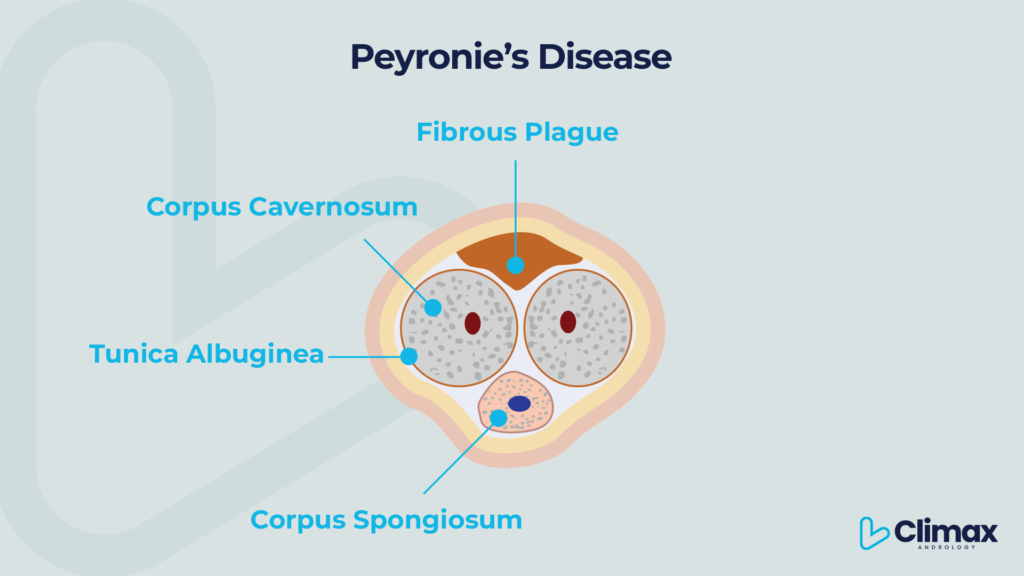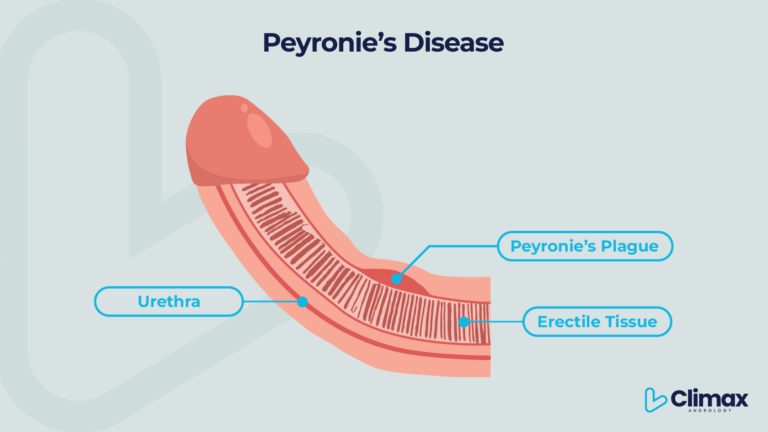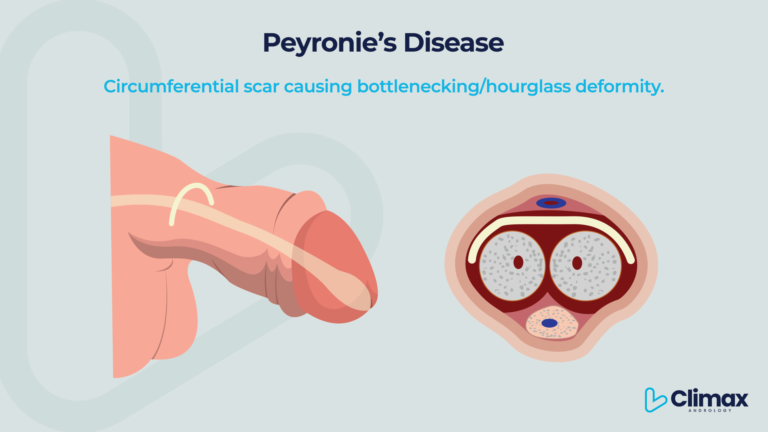Peyronie's Disease
What is Peyronie’s disease?
Peyronie’s disease occurs when there is the presence of fibrous, hard tissue (plaque) inside the penis, which causes it to bend, curve or narrow abnormally. This blemish can be felt through the skin and sometimes hurts in certain organ parts. The position of the scar will determine whether, during erection, it bends upward, downward or sideways. Some individuals may have a deformity like an hourglass instead of a curve whereby different areas along the length of their penises are narrowed down.



What causes Peyronie’s disease?

Injury to the Penis:
Microtrauma: Peyronie’s disease is believed to be caused by minor injuries or microtrauma that happen to the penis repeatedly and regularly, especially during sexual intercourse. These injuries may create tiny cuts in a fibrous casing called tunica albuginea, which envelops penile tissue. The body reacts by generating scar tissues (plaques) as it heals these wounds.
Macrotrauma: Sometimes, large-scale damage, such as forcefully bending an erect phallus, can instantly cause Peyronie’s ailment.
Genetic Factors:
Family History: Some indications indicate that Peyronie’s disease might run in families due to genetic causes. Guys with close relatives with the illness or any other collagen-related ailments are likelier to get it themselves.
Dupuytren’s Contracture: Dupuytren’s contracture refers to the abnormal thickening and scarring of connective tissues within palms, leading to bent fingers, among other symptoms; this condition also raises the chances of acquiring Peyronie’s disease, thus suggesting potential common genes or pathophysiology between them.
Disorders of Connective Tissue:
Certain systemic disorders affecting connective tissues throughout the body where they become abnormally thickened or scarred could increase susceptibility towards developing Peyronie’s ailment
Ageing:
The older you become, the more your risk factor for getting pyrones ailment proportionally escalates. This is because, with increasing years, elasticities in penile cells decrease, thereby making them prone to injuries followed by scar formations.
Inflammation or Immune System Response:
Some scientists propose that inflammation here means anything beyond normality—related immune responses may play a part in the aetiology of this disease… If so, what happens next is just simple biology—after healing, such wounds wrongly targeted against healthy parts would lead to scarring, eventually causing fibrosis, termed nowadays as “peyronies.”
Other Risk Factors:
Certain Health Conditions: Diabetes, hypertension and smoking have all been linked to higher chances of contracting peyroneis, possibly because they affect blood vessels’ functions as well as tissues’ repair capabilities.
Surgical or Medical Treatments:
Rarely does it occur, but it is still possible; some operations done on prostate glands plus radiation therapies used against cancer can cause Peyronies in men.
What are the symptoms of Peyronie’s disease?
- Curvature of the Penis: The most common sign is an observable bend or curve in the penis when it becomes erect. The direction may be upward, downward, or sideways and possibly its severity.
- Ache: Men who have this illness frequently experience soreness while having erections. Although the curvature persists even after healing, this pain tends to be strongest at the beginning stage of the ailment.
- Erectile Dysfunction (ED): Physical distortion as well as psychological disturbance caused by this condition can both result in difficulty achieving or sustaining a full erection among patients with Peyronies disease.
- Detectable Plaque: It is often possible to feel a tough lump or cord-like band under the skin on top of the shaft due to fibrous tissue development, which is also known as scar tissue; such areas are commonly benign but may cause considerable pain and disfigurement.
- Penis Shortening: During the healing process, there might occur abnormal amounts of collagen production leading to noticeable shortening or narrowing down the penile length, particularly during an erected state.
- Shifting in Penile Shape: Some males may see dents alongside hourglass-like thinning of their member’s middle part, which also curves around these regions.
- Diminished Flexibility In The Penises: Sometimes flexibility gets lost where a man might not be able to easily bend it when flaccid or straighten out completely during erection, thereby making such area less pliable than usual.
- Mental Torment: The psychological and emotional difficulties caused by the physical symptoms of Peyronie’s disease can lead to nervousness, sadness, and tension in relationships. Often, these emotions are brought on by how much this condition affects self-esteem through sexual function; therefore, emotional support must be part of treatment for such diseases.
What are the stages of Peyronie’s disease?
Peyronie’s disease stages include the acute phase and the chronic phase.
Acute Peyronie’s Disease: This phase is also known as the inflammatory stage, lasting six to 12 months. Usually, scar tissue starts forming beneath the skin of your penis, causing curvature or other deformities in shape. You might feel pain while erect or flaccid.
Chronic Peyronie’s Disease: The plaque in this phase has stopped growing and usually makes curvatures stable. At this time, pain will often go away but may still be present during an erection; additionally, many people will experience erectile dysfunction (ED)
What Treatments Are Available?
- • Observation: In less severe circumstances, it may be enough to observe that it does not worsen with time.
- Medications: Oral medications or drugs administered as injections, such as collagenase (Xiaflex), might help decrease plaque size and straighten curvature.
- Non-Surgical Treatments: Extracorporeal shock wave therapy; devices worn on the penis like traction devices; vacuum erection devices—all these things can be used non-surgically to minimise curves.
- Surgery: For individuals whose symptoms have become debilitating due to extreme peyronies severity levels—such cases call for surgical options like plicating incisions along areas where there is excess tissue growth followed by grafting procedures done using skin from elsewhere within one’s own body; alternatively implanting penile prostheses may also help straighten out an otherwise bent member so that it functions correctly again.
- Support: Emotional support through counselling and lifestyle changes, which can vastly improve quality of life overall, should not be underestimated.
At Climax Andrology, we understand the physical and emotional challenges that Peyronie’s disease can bring. Our experienced specialists are dedicated to providing expert care and customised treatment options that suit your unique needs. Don’t let Peyronie’s disease dictate your life—take proactive steps today. Schedule a consultation with Climax Andrology and embark on your journey toward recovery and restored confidence. Your health and well-being are our top priorities, and we’re here to guide you every step of the way.

Contact Us Today
Are you ready to address Peyronie’s disease or explore other treatment options? Don’t wait—reach out to us today! We support you if you have questions or are ready to schedule a consultation. Connect with us through:
- Email: [email protected]
- WhatsApp: Click to Chat
- Telegram: Click to Chat
- Call: TR: +90 537 522 6080 / UK: +44 7547 812874
- Request a Callback: Fill out this form, and we’ll call you back at your convenience.
At Climax Andrology Turkey, our dedicated team is here to answer your questions, schedule your consultation, and provide the care you need. We’re committed to helping you regain confidence and improve your quality of life. Don’t hesitate—contact us now!

F.A.Q About Peyronie Disease & Penile Curvature
Peyronie's Disease is a condition in which the penis curves or bends during an erection due to fibrous scar tissue called plaque developing on it. This can cause pain, difficulty with sexual intercourse and emotional distress.
The exact cause of this disease remains unknown but it is believed that trauma to the penis during sexual activity, sports or an accident could be responsible for it. Such injuries lead to formation of scar tissues. Genetic factors together with certain health conditions might also contribute towards its development.
- A bend or curve noticed in the penis.
- Pain experienced when having erections.
- Hard lumps or plaques felt beneath skin covering penis.
- Shortening of the organ.
- Erectile dysfunction sometimes happens as well.
Most often diagnosis is made by physical examination where doctor feels for presence of plaques on penis shaft; however in few cases imaging tests like ultrasound may be used to evaluate extent of scarring tissue if any present inside patient’s body cavity wall such as peritoneum lining abdominal organs etc..
Peyronie’s Disease affects only few men but still many numbers are estimated especially among those who have passed age 40+. According to research statistics alone one out every hundred male individuals could develop this illness within their lifetime span.
Sometimes mild cases may resolve spontaneously without treatment while majority will either stay same or worsen over time thus requiring medical attention which helps manage signs/symptoms and prevent further complications from arising.
There’re different ways to treat this condition depending on its severity level like:
- Oral medicines (though they don’t work well).
- Injecting into plaque directly to decrease curvature.
- Surgery in severe cases e.g., removing plaques or penile implants etc..
There is no known method of preventing such disease but risk factors can be reduced through injury prevention strategies as well as managing underlying health conditions.
Erectile dysfunction may result from peyronie disease due to difficulty getting hard, pain during sex, inability to maintain erection and decreased ability for sexual intercourse which affects overall satisfaction with relationship partner.
You need visit your doctor who will refer you see urologist – the specialist dealing mainly with male genital problems including this one – so that he gives proper diagnosis before providing relevant treatment options based on individual case scenario.
Surgical intervention normally advised only when other therapies fail completely or there severe deformity interfering significantly sexual life such as extreme curvature making penetration impossible etc..







